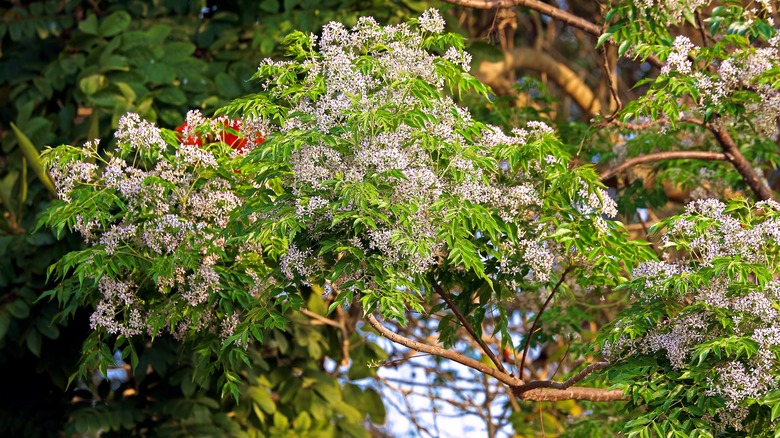Beautiful Alternatives To Invasive Chinaberry Trees That'll Make Your Yard Stand Out
Chinaberry trees (Melia azedarach) have a lot going for them. They imbue the landscape with a chocolaty fragrance, illuminate spring-summers with lilac flowers, and animate wintry landscapes with inebriated birds gorging on their golden fruits. They dome the area with their 40-foot-wide canopies, shading it. Plus, they can withstand pollution, compaction, drought, and subpar drainage. Regrettably, this adaptability has worked conversely, turning them into "weed" trees. Barring in the northern ranges where they're frost-killed, chinaberry trees are known to escape from yards into natural areas, devastating native stands with their allelopathic compounds. They're considered invasive in most southern states, including California, Texas, Florida, South Carolina, Georgia, and Virginia. For this reason, you must remove this invasive plant species from your garden. Fortunately, there are plenty of well-behaved tree options you can consider to reclaim space from chinaberry trees.
To mimic their decorative appeal sans intrusion, get their southern U.S. native look-alike: western soapberry (Sapindus saponaria var. drummondii). It's a similarly sized tree, towering over 30 feet, with pollinator-friendly yellow fruits that turn black when ripe, serving as crucial winter food. They have trifling pruning and watering requirements and showcase high drought, wind, and pest resistance. However, like chinaberry trees, their fruits are toxic for pets and children and pose a slip hazard, reducing their utility around high-traffic areas. They also occasionally send out suckers (except in clay soil), which must be pulled out to keep their assertive tendencies in check. There are a few other alternatives you could try.
Other beautiful alternatives to invasive chinaberry trees with wildlife value
To replicate the benefits chinaberry trees offer to songbirds and hummingbirds (such as shelter and food), switch to elderberry trees (Sambucus canadensis). Hummingbirds will keep returning to your yard for this tree's show-stopping colors due to their creamy white blooms and purplish-black berries in zones 4 through 8. However, they don't grow as tall, typically staying under 12 feet. Aside from springing volunteer seedlings, they grow unwieldy with age. So, pop them in naturalized or woodland settings or mass as hedges in wet soils, and keep them out of reach of your kids since their fruits are mildly toxic.
If you value chinaberry trees for their spring flowers, consider plum trees (prunus spp.), especially Mexican plum (Prunus Mexicana). Their bare branches sport fragrant white petals from February through April, luring in bees. Meanwhile, their edible mauve plums make a showy presence later, attracting birds and the jelly-maker inside you. While they're conducive through zone 6 in part-to-full sun locations, they can get messy because of the fruit drop, so pick their location accordingly.
Add a unique texture to your yard with devil's walking stick's (Aralia spinosa) gnarly 15-foot physique, enclosed by fall-changing compound leaves, which are much bigger than chinaberry's. Besides hosting butterflies and songbirds, it's among the plants that will upgrade your home security due to its thorns. It's deer-resistant and cold-hardy through zone 4, but it might turn aggressive in yards because of seeds and vegetative growth. Accidental contact with bark and fruits may cause skin irritation.

